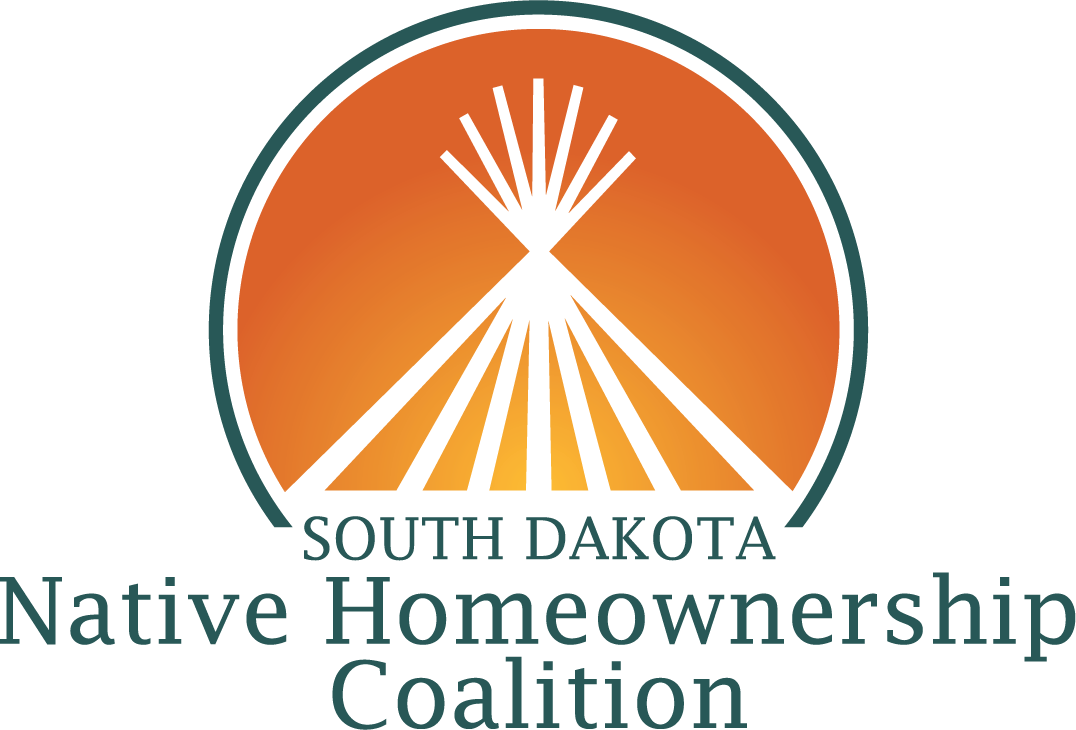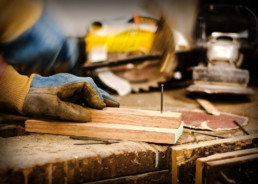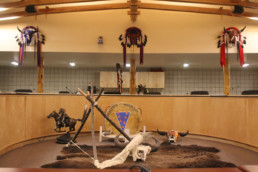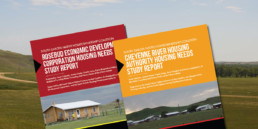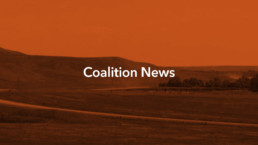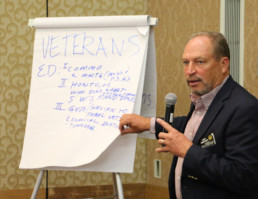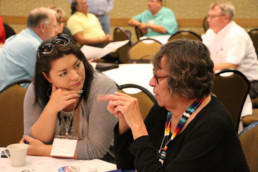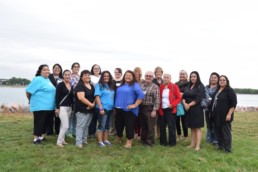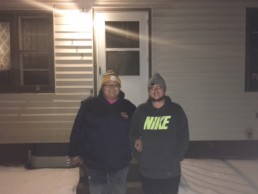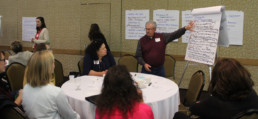Coalition Responds to Contractors’ Input
In roundtable discussions with contractors about how to increase housing stock on South Dakota’s reservations, contractors have shared some of the obstacles to residential building, including the lack of inspectors and work-ready employees. In response, our Physical Issues Committee is working to support efforts to increase the number of certified inspectors, and designing a summer internship program for building trades students at Oglala Lakota College to work directly with contractors.
In January, the Coalition held a two-day training to support contractors, TDHE staff, and other nonprofit housing staff in preparing for the inspector certification exam. Thirty seven participants completed this training, and will be taking the certification exam. We wish them luck!
Through the construction internship pilot program, up to twenty students from Oglala Lakota College will spend ten weeks this summer working directly with contractors on the Pine Ridge and Cheyenne River Reservations. The internship will provide the opportunity for students to develop relationships with contractors (leading to potential employment in the future), and gain hands-on work experience. The program will also incorporate financial education and workforce readiness training for students.
Sisseton Wahpeton Oyate Housing Authority Secures Victory Through Advocacy!
Through a persistent effort, the Sisseton Wahpeton Oyate Housing Authority has secured an important tax victory which will result in more affordable mortgages for tribal members. Through this effort, individual home buyers constructing their homes have been granted a sales tax exemption for “Indian Use Only Projects,” which means that they will not have to pay sales tax on materials used to build their homes on trust land. According to JC Crawford, Executive Director of the Sisseton Wahpeton Housing Authority, “eliminating the sales tax makes a real difference for home buyers. At the end of the day, the savings can determine whether or not one of our tribal members can qualify for their mortgage.”
Initial advocacy efforts around the sales tax provision began back in 2012, when five families building in the Long Hollow subdivision filed a request for consideration of the tax exemption – which is one-page, on-line fillable form. When their request was denied, the Sisseton Wahpeton Oyate and their legal group got involved, and the tribal chairman set up a meeting with the Governor. Following this meeting, the decision to deny the exemption request was reversed, and the exemption was granted. Through the exemption process, the contractor building the home on trust land gets a letter indicating that all materials purchased for the home will be exempt from state sales tax.
When a new group of families began home construction in June 2016, the Housing Authority assumed that based on the prior decision, their exemption requests would granted. They were surprised to learn in August 2016 that the requests were denied. The Housing Authority worked with the Sisseton Wahpeton Oyate Tax Office to begin advocacy efforts once again to secure the exemption for tribal families, and in November 2016, a tribal delegation traveled to Pierre to meet with the Secretary of the SD Department of Revenue, Andy Gerlach. In this meeting, the delegation needed to show that the tribe had involvement with families throughout the home construction and buying process. At the meeting, the decision to deny the exemption was reversed, and the exemption was granted.
According to Angie Johnson, Administrator/Counselor of the T Yamni ~ Sisseton Wahpeton Oyate, this policy victory shows the importance of “pushing forward, pushing forward, and not giving up.” She states, “What’s critical here is that we’re saving our homebuyers money. Most are low-income, and we try to save as much as we can on their home – which they’ll have for the rest of their lives.”
Housing Needs Assessments Represent Historic Partnership
Two tribal entities, Cheyenne River Housing Authority (CRHA) and Rosebud Economic Development Corporation (REDCO), recently completed housing needs assessments for their respective communities. The two organizations were chosen through an application process that we facilitated in September 2015. The studies were sponsored by the South Dakota Housing Development Authority and mark the first-ever state-supported housing needs assessments of tribal lands. We couldn’t be happier about this partnership, and hope to build on it moving forward.
Each study accurately assessed household characteristics, demographics, and the unique supply and demand characteristics of the local housing markets. While housing development on the reservations is dominated by low-income rentals, the studies revealed a substantial demand for homeownership. The lack of available housing for those who do not qualify for low-income units has forced many community members who currently have employment on the reservation to move off-reservation for housing. The study points out that emigration of skilled individuals off the reservation could significantly stunt community and economic development.
“Many families think they aren’t eligible for homeownership, but they just need a pathway to get there,” says Sharon Vogel, Executive Director of CRHA. They plan to apply information gained from the study to a 188-unit housing development in Eagle Butte.
Taffy Lafferty of REDCO says they will apply study findings to a consumer-driven development of a 750-unit mixed-use subdivision in Mission. She says, “Our people want a safe place to live. Safety and stability is the priority. Homeownership can bring that.”
The studies not only give each reservation a clear idea of specific housing needs (i.e. – number of bedrooms, affordable monthly payments), but they also provide a better understanding of the type of homeowner preparedness strategies (i.e. – financial education, credit coaching) they will need to implement in order to increase homeownership rates. The studies also provide recommendations on culturally-relevant housing development strategies, such as multi-generational housing.
Coalition Requests Proposals for Video Production
Native Homeownership is Possible
Request for Proposals
Questions
Coalition Launches Task Force to Increase Homeownership Opportunities for Native American Veterans
We are pleased to announce the formation of a new committee that will work to increase access to homeownership resources for Native American veterans. The committee will be co-chaired by Secretary of the South Dakota Department of Veterans Affairs, Larry Zimmerman, and Manaja Hill, the Standing Rock Sioux Tribe’s Veteran Service Officer. The working group will be focusing on veterans’ homeownership matters and specifically address housing stock and land issues, homebuyer education, and subsidies.
“The key step for this committee is bringing the tribes and the state together,” says Secretary Zimmerman.
Hill explains that there are many resources for Native American veterans available, but committee members have found that, in some cases, veterans are not aware of the all of financial and housing counseling resources available that would make their homeownership goals more attainable.
“We will be connecting all of the programs with the specific needs of the veteran,” Hill says. This would include programs available through the tribe, county or state, and the network of organizations that promote homeownership opportunities in Native communities through the Coalition.
In order to do this, the committee will produce guides that will serve as a centralized information resource for South Dakota’s Native American veterans. In order to be more accessible, the guides will use “veteran’s lingo” says Secretary Zimmerman who is a veteran himself. Hill, also a veteran, adds that information in the guides will be categorized by each of the state’s nine tribes since “tribes are not cookie cutter,” and each offers unique benefits.
Hill hopes that their work will be used as a model by other states to help even more veterans. He believes that low-income rental programs “are the foundation of poverty” and that “our vets deserve more.” He says, “Homeownership gives our veterans a sense of pride. They have some thing to take care of. These are things that they are familiar with from being in the service.”
The Coalition launched the Native Veterans Homeownership Committee during its planning session as a pre-cursor to the South Dakota Housing Development Authority’s 26th Annual Housing Conference. The planning session was attended by nearly 100 individuals from tribal, state, and federal agencies, as well as nonprofit organizations, colleges, and financial institutions. In addition to the launch of the veterans committee, the pre-conference event also included working groups that will shape the Coalition’s activities for the next year, and informational sessions on the Coalition’s new statewide impact tracking system for homeownership practitioners and housing needs assessments conducted recently on the Cheyenne River and Rosebud Reservations.
Coalition Energized for Another Year of Impact!
On October 24-26, 2016, over 70 members of the South Dakota Native Homeownership Coalition gathered for our annual planning session and other activities held in conjunction with the South Dakota Housing Development Authority’s Annual Housing Conference in Pierre, South Dakota. The series of events provided a platform for reflecting on successes, developing collective strategies, and celebrating accomplishments.
Annual Planning Session
Coalition members participating in the planning session represented the wide range of organizations that make up the Coalition, including tribally-designated housing entities (TDHE’s), tribes, community development financial institutions (CDFIs), nonprofits, federal and state agencies, and lenders. The day’s agenda included:
- Review of 2016 Coalition accomplishments
- Small group break-out discussions on “hot topics”
- Updates on housing needs studies and impact tracking efforts
- In-person committee meetings to develop 2017 milestones
- Reflections
State of the Coalition
Following our opening prayer and introductions, Coalition member Tawney Brunsch of Lakota Funds reviewed 2016 accomplishments and the “State of the Coalition.” She highlighted accomplishments in four areas: membership commitment, stakeholder diversity, funder support, and impact, emphasizing the importance of each to the Coalition’s success.
The Coalition also conducted a membership survey earlier this fall to track benefits and impacts; the highlights of this survey are reflected in the infographic below.
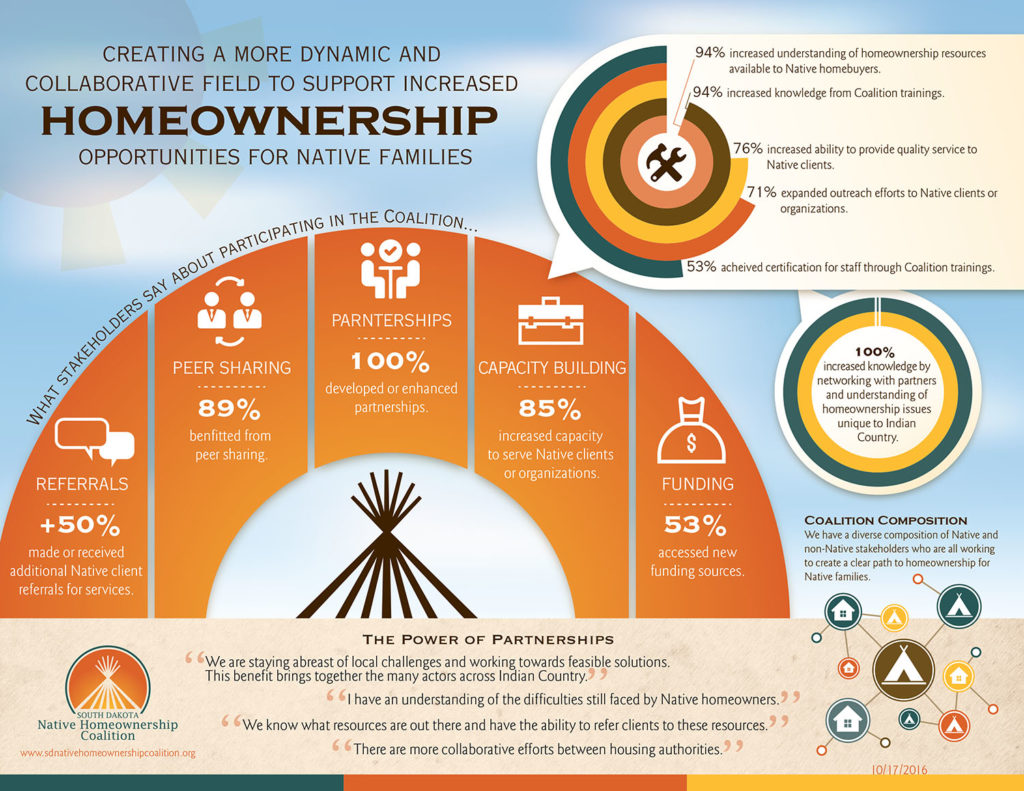
As part of the “State of the Coalition,” committee chairs highlighted the milestones that our working committees have achieved over the past year. These accomplishments included:
- Delivering an inspector training in April 2016 to over 75 participants
- Creating leasehold flowcharts to map out help clarify the process
- Facilitating a post-purchase counseling certification training for 16 practitioners
- Enhancing funding information on the Coalition’s website
- Delivering a down payment assistance workshop at the Annual Housing Conference
- Conducting an annual site visit to a tribal community (Cheyenne River in June 2016)
- Hosting a Tribal Leaders’ Summit in May 2016 focusing on Native veterans’ issues
- Facilitating a training on “Developing Successful Partnerships with Native Organizations”
New Veteran’s Homeownership Committee
After sharing these 2016 accomplishments, Coalition members had the opportunity to participate in small group discussions on “hot topics,” including:
- Native veterans homeownership issues
- Development of a construction internship program with local colleges
- Enhancing the Coalition’s communication efforts
- Income-generating strategies for the Coalition’s long-term sustainability
While each small group had productive discussions and developed clear next steps, the highlight of these discussions was the creation of the new veterans’ homeownership committee. The committee will be co-chaired by Secretary of the South Dakota Department of Veterans Affairs, Larry Zimmerman, and Manaja Hill, the Standing Rock Sioux Tribe’s Veteran Service Officer.
Impact Tracking Database Development
As a statewide Coalition, we know that tracking our impact is critical to our work and long-term sustainability. The Coalition is partnering with Sweet Grass Consulting to design and implement a data tracking system to capture the efforts of individual Coalition member organizations. The information we are tracking focuses on training, coaching, and home loan packages and approvals.
Following lunch, Coalition members had the opportunity to learn more about these efforts. Colleen Steele of Mazaska and Elaine Kennedy of Hunkpati joined Michael Brydge of Sweet Grass Consulting in discussing the tool, describing their experience with the tool, and emphasizing the benefits that data can provide for their individual organizations as well as the Coalition.
Housing Needs Studies Progress Report
Attendees then learned about the Housing Needs Studies the Coalition has facilitated for the Cheyenne River Housing Authority (CRHA) and the Rosebud Economic Development Corporation (REDCO). With the support of the South Dakota Housing Development Authority, Big Water Consulting has worked with staff of CRHA and REDCO to design and carry out studies to support their homeownership efforts. Sharon Vogel of CRHA and Taffy Lafferty of REDCO joined Kevin Klingbeil of Big Water to share how the studies were conducted and their value in designing homeownership projects.
Establishing 2017 Milestones
The planning session also provided the opportunity for Coalition members to conduct in-person committee meetings to review 2016 milestones and plan 2017 milestones. Some of the 2017 milestones include:
- Development of a pilot construction internship program
- Follow-up inspector training focused on certification exam preparation (January 2017)
- Financial coaching certification training for homebuyer practitioners
- Loan packaging training for the Native American Direct Loan (VA)
- Annual visit to tribal community
Reflections
Participants concluded the planning session by sharing their reflections on the day, and the Coalition overall. Some of these reflections included:
- Today was a great day.
- Adding the veterans committee was a great move.
- Glad to be part of this movement – we learn something new every time.
- Homeownership is a “revolution.”
- It takes a village – we are all part of the puzzle.
- Excited that North Dakota is here to learn.
- It’s great to the VA here.
- Warms my heart to see returning members and new members stepping up.
Native Homeownership Track of Sessions
Beyond the planning session, the Coalition also organized the Native Homeownership Track of Sessions at the Annual Housing Conference, which included five workshops:
- Preparing a Workforce to Increase Housing Stock for Native Homeowners: Thunder Valley’s Innovative Workforce Development Program
- Increasing Homeownership Opportunities for Native Veterans
- Making Native Homeownership Affordable: Sources of Downpayment Assistance
- Tips for Effective Grant Management
- Everyone Has a Voice: the Importance of Policy Work to Promote Native Homeownership
The workshops were very well-attended, and participants appreciated the chance to tackle challenges together, learn from one another, and hear about successful strategies to increase homeownership for Native families in South Dakota.
Coalition conducts successful Post Purchase Certification Training in Pierre!
On September 22, 2016, sixteen homebuyer practitioners from around the state became certified to teach post-purchase homebuyer education in their communities. These practitioners completed an intensive 4-day training on “Post Purchase Education Methods” sponsored by the Coalition in coordination with NeighborWorks America and Neighborworks Dakota Home Resources.
The training focused on important information for homebuyers, including:
- Budgeting and Finances
- Maintenance
- Community Issues
It also included a number of hands-on maintenance activities for participants. Participants especially liked the hands-on activities (including fixing a window screen and drywall) and the chance to get to know fellow practitioners working to assist Native families attain homeownership.
Coalition Members Visit Cheyenne River to Learn About Homeownership Efforts
On June 29, 2016, over fifty members of the SD Native Homeownership Coalition visited the Cheyenne River Reservation, the Coalition’s third annual visit to a tribal community. In 2014, Coalition members visited the Pine Ridge Reservation and in 2015, members visited the Sisseton Wahpeton Oyate. Coalition partners on the Cheyenne River tour/convening represented TDHEs, Native and non-Native nonprofit organizations, Native and non-Native CDFIs, federal partners (including USDA, HUD, and the VA), and state partners (including the SD Housing Development Authority and the Department of Tribal Relations).
The day started in Mobridge, with an opening prayer, welcome remarks by Sharon Vogel, the Executive Director of the Cheyenne River Housing Authority, introductions, and milestone updates from the Coalition’s different committees. From Mobridge, Coalition members traveled by bus to Eagle Butte, a two-hour trip. On the way, partners saw a diverse mixture of homeownership homes that ranged from CRHA Mutual Help homes to mortgage loan financing (VA, USDA, HUD-ONAP 184), and visited the White Horse community. The bus trip provided the opportunity for Coalition members to visit with one another, see the remote and isolated nature of Cheyenne River communities, and gain an understanding of the pros and cons of these locations.
In Eagle Butte, Coalition partners visited the impressive hospital staff quarters neighborhood, and saw the 160 acre Badger Park site that the Housing Authority is developing. With infrastructure in place, including utility service lines, curbs, gutters, and road, the Housing Authority is scheduled to start having homes go up within the year. Coalition members were impressed by the site, and are looking forward to a return visit to see completed homes.
After visiting the Badger Park site, Coalition members convened for lunch, with remarks by Tribal Chairman Harold Frazier and Bush Fellow Eileen Briggs. Lunch included a birthday cake to celebrate the third birthday of the Coalition – the group’s first convening was held on June 27, 2016 in Pierre! Following lunch, Coalition members convened at the Oglala Lakota College/Cheyenne River College Center for a series of afternoon discussions. After a welcome by Dave West, Jr., the Center Director, Taffy Lafferty and Sharon Vogel shared the preliminary results of their organizations’ housing needs assessments, which are being facilitated by the Coalition and supported by the SD Housing Development Authority. Coalition members then met with three homeowners to learn about some of the challenges they encountered, and then Sharon reviewed the key steps to homeownership.
Overall, it was a packed day, and participants reported that they were very impressed by the work of the Cheyenne River Housing Authority, and appreciated “covering the reservation where the action is.”
Crow Creek Tribal Member Realizes Homeownership Dream
On January 5, 2016, Airryn Big Eagle (Crow Creek Sioux) purchased a home after saving for two years through Hunkpati Investments’ matched savings program. As a Native community development financial institution and a member of the South Dakota Native Homeownership Coalition, Hunkpati Investments’ matched savings program, also known as an Individual Development Account (IDA) program, enables tribal members to build assets through homeownership, secondary education, or business development. By participating in this program Airryn Big Eagle was able to receive $8.00 for every dollar she deposited into a special savings account.
Airryn says, “I always dreamed of owning my very own vehicle, my own business, and having a home to call my own. As a young Native American woman, I never thought that I would have any of those things. I believed that all of the above was nothing but a dream, and that’s all it would ever be.”
Airryn began working with Hunkpati Investments in 2012 to build her personal financial skills, improve her credit, and start her own business. She enrolled in the matched savings program in July of 2013 and discovered homeownership might be a possibility for her. She says, “I could not get the idea of becoming a homeowner out of my head. It had always been a dream of mine.”
Airryn took the homeownership preparedness course that Hunkpati offered, and learned about all of the expenses and steps she would need to take in order to make her dream come true. She looked into several financing options and ended up choosing the USDA Rural Development loan. She comments on the moment she found out she was approved for her loan, “I cried like a baby. I was worthy of a home loan!”
After a long commitment to saving and much research, Airryn was able to use the funds from her Individual Development Account as a down payment for a home within her budget. She went through the necessary steps to close the loan, and is now a proud homeowner.
2015 Annual Housing Conference a Success!
Much shared and learned at the Coalition’s events during conference.
The South Dakota Native Homeownership Coalition had another successful year at the South Dakota Housing Development Authority (SDHDA) Annual Housing Conference in Pierre. Highlights of the conference included:
- A terrific planning session
- Five workshops through our Native Homeownership Track
- Special sessions on impact tracking and Sisseton Wahpeton Oyate’s new risk mitigation pool
It was also wonderful to see one of the Coalition’s founders, Elsie Meeks, honored by the SDHDA through the “Friend of Housing Award”! Coalition members are excited about what we can accomplish as we move forward together.
Summary of Native Conference Events
Strategic Planning Check-in
Over seventy Coalition partners attended our one-day “Strategic Planning Check-in” pre-conference session on Monday, October 26th. Partners spent the day discussing the benefits of the Coalition, revisiting the Coalition’s original strategic plan, looking at committee accomplishments and future milestones, learning about baseline data collection efforts, and exploring different key issues, including income-generation strategies to promote the Coalition’s sustainability, how to take communication efforts to the next level, long-term impacts the Coalition is working to achieve, and organizational structure options.
Risk Mitigation Pool – Memorandum of Understanding Signing
On Monday, October 26th, J.C. Crawford, Executive Director of the Sisseton Wahpeton Oyate Housing Authority and Bruce Jones, Interim State Director of USDA/Rural Development signed a Memorandum of Understanding creating a “risk mitigation pool” to offset the risk of foreclosure for loans originated on trust land. Through this initiative, the Sisseton Wahpeton tribe will purchase any loans at risk of foreclosure and re-sell the home to another qualified tribal member. Coalition members interested in learning more about the risk mitigation pool participated in a Coalition discussion Tuesday morning, where the different partners explained the new initiative and its creation in more detail.
Impact Tracking Working Session
On Tuesday, October 27th, homeownership practitioners participated in an impact tracking session, discussing impacts that we will be tracking to document the impact of the Coalition, and providing feedback on a data collection tool developed by Sweet Grass Consulting.
Native Homeownership Track
Coalition members also participated in five workshops through the Native Homeownership Track, focusing on a conversation with funders, navigating the leasehold process, understanding housing needs assessments, working with contractors to increase housing stock on reservations, and leveraging “lump sum” payments to increase Native American homeownership. These workshops were designed by our Coalition committees, and led, in large part, by Coalition members.
Post-Conference Debriefing Session
Coalition members gathered at the conclusion of the conference to reflect on the Coalition’s events over the week and look ahead to what lies on the horizon for 2016. Members committed to completing leasehold and homebuilding process flowcharts currently in progress, reaching out to tribal leaders, conducting an inspector certification training, and sharing the work of the Coalition on a regional and national level.
